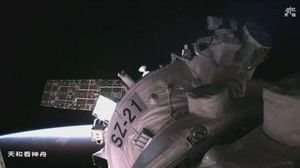It was a week of high-stakes diplomacy, shifting trade alliances, and economic recalibration across the globe as leaders from North America, Asia, and Europe grappled with the fallout of protectionism, tariffs, and an evolving world order. The period ending November 1, 2025, saw central banks navigating choppy waters, governments bracing for economic headwinds, and trade deals being inked and reconsidered—sometimes simultaneously—on the world stage.
In Canada, the Bank of Canada (BoC) delivered a quarter-point interest rate cut, bringing a sigh of relief to some but little hope for further reductions in the near term. As reported by the Toronto-Dominion Bank, the BoC signaled a pause, stating it was "comfortable with where the policy rate now stands," effectively shrinking the likelihood of more cuts in the coming months. This decision arrives on the heels of worrying economic data: August’s industrial GDP showed a 0.3% contraction, erasing gains from the previous month, and the unemployment rate remained elevated at 7.1% as of late October. The labor market, despite a recent bump in employment, continued to show signs of strain, with population growth at stall speed and domestic-oriented sectors faring better than those reliant on U.S. exports.
Governor Macklem underscored the limits of monetary policy in the current environment, stating at a press conference, “Structural damage caused by tariffs is reducing the productive capacity and adding costs,” which in turn restricts "the ability of monetary policy to boost demand while maintaining low inflation." The BoC’s Monetary Policy Report highlighted that due to slower labor force growth, the economy doesn’t need as many new jobs to keep unemployment in check. But with trade uncertainty still looming, the outlook remains uncertain.
Hopes are now pinned on the upcoming federal budget, expected next week, which Prime Minister Mark Carney has promised will address Canada’s structural challenges, particularly the need to diversify trade relationships. The government aims to double non-U.S. exports within a decade, a goal that will require hefty investments in trade-facilitating infrastructure and a substantial commitment to raise defense spending to 5% of GDP by 2035. Carney, addressing the Asia-Pacific Economic Cooperation (APEC) summit in South Korea, didn’t mince words: “The old world of steady expansion of rules-based liberalised trade and investment, a world on which so much of our nations’ prosperity – very much Canada’s included – is based, that world is gone.”
Meanwhile, south of the border, the United States faced its own economic and political turbulence. The government shutdown, now in its 31st day as of October 31, 2025, threatened to become the longest in U.S. history if it stretched past November 3. With no clear resolution in sight, Senate Democrats rejected a stopgap funding measure for the thirteenth time, and Republicans were hesitant to consider piecemeal solutions.
Amidst the domestic stalemate, President Donald Trump embarked on a whirlwind tour of Asia, pursuing what he described as “great success” in reducing trade tensions. According to the BBC, Trump met Chinese President Xi Jinping in South Korea during the APEC summit, where the two leaders agreed to halve the U.S. tariff on Chinese chemicals linked to fentanyl production from 20% to 10%. In return, China pledged to defer stringent export controls on rare earths for at least a year and to boost purchases of U.S. soybeans. Both sides also suspended new port fees and reciprocal tariff hikes scheduled for November 10. Trade expert Lars Jensen told the BBC that these moves constitute an “extended truce” rather than a definitive resolution: “Overall, this does point to some de-escalation in the trade war between US and China, but there is not necessarily a long-term certainty of the trade environment given that some of these agreements are 1-year only.”
Kelly Ann Shaw, a former economic adviser to Trump, echoed these sentiments, saying the talks were about “managing the breakup in a way that does a limited amount of damage,” but warned, “this is not a relationship that is necessarily going to improve dramatically anytime soon.”
Trump’s Asia tour also included stops in Malaysia and bilateral talks with ASEAN members, where he finalized rare-earths memorandums of understanding with Malaysia and Thailand, and celebrated mediating an end to the Thailand-Cambodia conflict. However, he notably skipped the main APEC leaders’ meeting, underscoring the U.S. disengagement from multilateralism in favor of bilateral deals. As reported by The Guardian, the U.S. also signed a critical minerals agreement with Japan, opening a new market for Japanese nuclear technology and military purchases.
Not everyone is convinced that these bilateral deals are the answer. Chinese Premier Li Qiang, speaking at the first-ever meeting of the Regional Comprehensive Economic Partnership (RCEP)—which notably excludes the U.S.—called for nations to “jointly uphold free trade and the multilateral trading system, oppose all forms of protectionism, and further advance the process of regional economic integration.” The RCEP now covers nearly a third of the world’s population and global GDP, a stark reminder of the shifting landscape as the U.S. steps back from multilateral agreements.
Back in the U.S., the Federal Reserve responded to the uncertain climate by cutting its benchmark rate by 25 basis points, bringing the target range to 3.75%-4%, and announcing an end to quantitative tightening as of December 1, 2025. Fed Chair Jerome Powell struck a cautious tone, saying a December rate cut “is not a foregone conclusion,” and acknowledging a split among Federal Open Market Committee members. The ongoing government shutdown has created what Powell described as a “data fog,” making it harder for policymakers to chart a clear course. Market odds for a December cut have fallen to 70%, and the Fed appears to be in wait-and-see mode, with the possibility of further action hinging on new data once the government reopens.
Elsewhere, the ripple effects of U.S.-China trade tensions are being felt worldwide. The European Automobile Manufacturers’ Association warned that Chinese export curbs on semiconductors could force several European carmakers to halt production, with “assembly line stoppages might only be days away,” according to ACEA director general Sigrid de Vries. In the UK, the government announced a £420 million annual electricity cost saving for 500 energy-intensive businesses starting in April 2026, while the Chartered Institute of Export & International Trade prepared to launch a new industry-recognized standard for customs intermediaries.
As the dust settles from a week of rapid-fire announcements, one thing is clear: the era of predictable, rules-based trade is over. Policymakers, businesses, and workers alike are adjusting to a world where uncertainty is the new normal, and where each handshake—or handshake withheld—can shift the economic winds for years to come.




